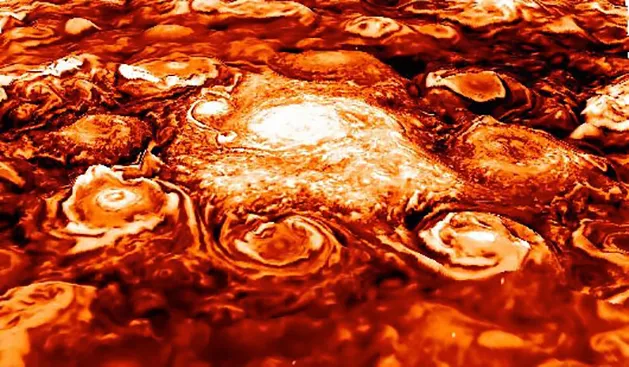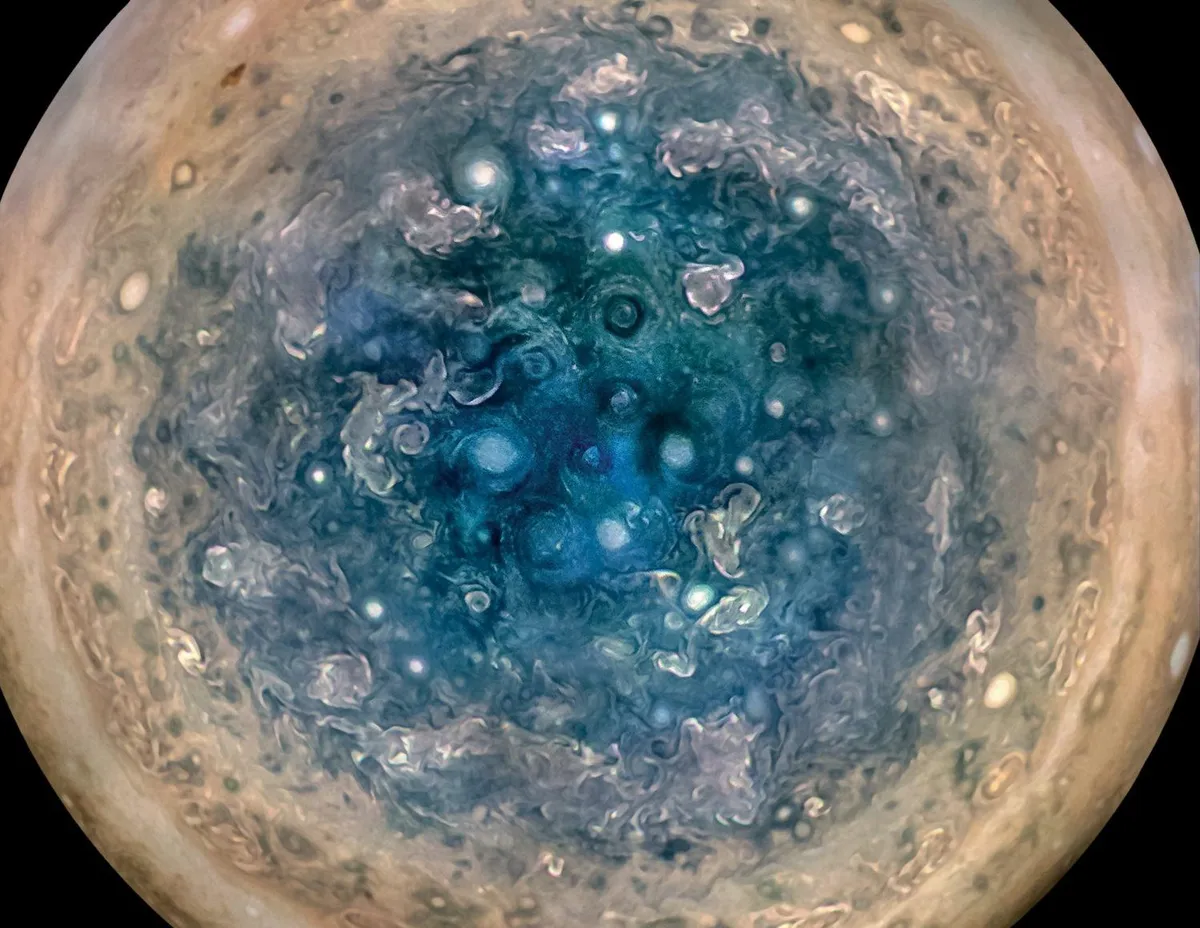"Everything about Jupiter is extreme. The planet is home to gigantic polar cyclones bigger than Australia, fierce jet streams, the most volcanic body in our Solar System, the most powerful aurora, and the harshest radiation belts."
Scott Bolton, principal investigator of NASA's Juno spacecraft currently orbiting Jupiter, has presented the latest findings from the mission during a briefing in Vienna on Tuesday 29 April 2025 at the European Geosciences Union General Assembly.

Bolton and the team showed how Juno has gained new insights into what's going on beneath the surface of Jupiter's atmosphere, as well as its moon Io, the most volcanic body in the Solar System.
The spacecraft's study of Jupiter has helped scientists better understand the rapid jet stream zipping round Jupiter's stormy north pole.
Juno has also revealed for the first time the subsurface temperature profile of moon Io, enabling scientists to learn more about its inner structure and volcanic activity.

Lava still flows on Io
Jupiter's moon Io is a fiery world whose volcanoes were first confirmed by scientist Linda Morabito in 1979, using images captured by the Voyager spacecraft.
Today, the gas giant is being explored by NASA's Juno spacecraft, equipped with a microwave radiometer (MWR) that can peer through Jupiter's clouds.
The Juno science team have used this instrument to take a look at Io, combining data with the probe's Jovian Infrared Auroral Mapper (JIRAM).
"The Juno science team loves to combine very different datasets from very different instruments and see what we can learn," says Shannon Brown, a Juno scientist at NASA’s Jet Propulsion Laboratory in Southern California.
"When we incorporated the MWR data with JIRAM’s infrared imagery, we were surprised by what we saw: evidence of still-warm magma that hasn’t yet solidified below Io’s cooled crust. At every latitude and longitude, there were cooling lava flows."
Around 10% of Io's surface has remnants of slowly-cooling lava just beneath the surface, the results suggest.
This data could help planetary scientists decipher how Io's surface is renewed so quickly, as well as how heat moves from its interior to its surface.
"Io’s volcanos, lava fields and subterranean lava flows act like a car radiator," says Brown, "efficiently moving heat from the interior to the surface, cooling itself down in the vacuum of space."
JIRAM data shows the most energetic eruption in Io’s history (identified by Juno on 27 December 2024) was still firing out lava and ash as recently as 2 March 2025.
Juno's flyby on 6 May 2025 should enable scientists to confirm this.

Jupiter's temperature
Juno has also been carrying out a unique manoeuvre, whereby it transmits a radio signal to Earth and back, the radio signal passing through Jupiter's atmosphere twice as it does so.
The effects of Jupiter's atmosphere on the radio waves enables mission scientists to get more info about the temperature and density of the planet's atmosphere.
So far, Juno has completed 26 of these 'radio occultation soundings', which have achieved the first ever temperature measurement of Jupiter’s north polar stratospheric cap.
The technique found that the region is about 11°C cooler than its surroundings and is encircled by winds travelling at speeds of 100 mph (161 kph).

Jupiter's stormy poles
Jupiter is known as a stormy gas giant, and one of the key achievements of the Juno mission is the fact that its polar orbit – taking the spacecraft from pole to pole – has given scientists a view of the planet not seen before.
Juno has revealed the long-term movement of Jupiter’s north polar cyclone and the eight cyclones encircling it.
Scientists have found that each storm drifts toward the pole, just like how hurricanes move across Earth.
Jupiter’s cyclones cluster together as they get closer to the pole, and begin interacting with each other.

"These competing forces result in the cyclones ‘bouncing’ off one another in a manner reminiscent of springs in a mechanical system," says Yohai Kaspi, a Juno co-investigator from the Weizmann Institute of Science in Israel.
"This interaction not only stabilises the entire configuration, but also causes the cyclones to oscillate around their central positions, as they slowly drift westward, clockwise, around the pole."
"One of the great things about Juno is its orbit is ever-changing, which means we get a new vantage point each time as we perform a science flyby,' says Scott Bolton.
"In the extended mission, that means we’re continuing to go where no spacecraft has gone before, including spending more time in the strongest planetary radiation belts in the Solar System.
"It’s a little scary, but we’ve built Juno like a tank and are learning more about this intense environment each time we go through it."
What are your favourite moments from the Juno mission so far? Let us know by emailing contactus@skyatnightmagazine.com

